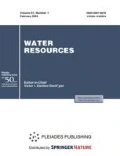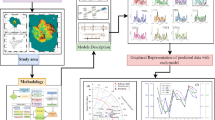Abstract
Predicting the Suspended Sediment Load (SSL) of the river is a very significant and challenging task. Being a non-linearity in the SSL data, it requires a non-linear method to get predicated in absence of field measurements. In recent decades, the application of Artificial Neural Networks (ANNs) has been considered as a milestone for the prediction of different hydrological parameters. Therefore, the present study was performed to investigate the application of ANNs to estimate the total SSL, particularly in the absence of river discharge data. The predication of SSL was done for the Ganga River at a station situated in the city of Varanasi, India. A multilayer perceptron (MLP) ANNs with a back-propagation algorithm were used to predict the SSL. The reliability of models was tested using the performance criteria such as Normalized Root Mean Square Error (NRMSE), Theil’s U statistics and Correlation coefficient. Several input parameters like rainfall, SSL, River stage. River depth and change in river bed level were used on the basis of different cases and tested to predict the SSL. The results show that the model performed efficiently to predict the SSL in the Ganga River, even in the absence of daily discharge data of the river. The values of SSL were also predicted using the predicted previous time step values of SSL to simulate the model in-case of missing field values. The model was found efficient to predict the values up to 95% of accuracy in-case of missing field value of SSL.










Similar content being viewed by others
REFERENCES
Agarwal, A., et al., Simulation of runoff and sediment yield using artificial neural networks, Biosyst. Engin., 2006, vol. 94, no. 4, pp. 597–613.
Ahmad, S. and Simonovic, S.P., An intelligent decision support system for management of floods, Water Resour. Manage., 2006, vol. 20, no. 3, pp. 391–410.
ASCE Task Committee, Application of artificial neural networks in hydrology. Artificial neural networks in hydrology. I: Preliminary concept, J. Hydrol. Engin., 2000, vol. 5, no. 2, pp. 115–123.
Atiya, A. and Ji, C., How initial conditions affect generalization performance in large networks, IEEE Trans on Neural Network, 1997, vol. 8, no. 2, pp. 448–451.
Dalezios, N.R., Eslamian, S., Ostad-Ali-Askari, K., Rabbani, S., and Saeidi-Rizi, A., Sediments, in Encyclopedia of Engineering Geology, Encyclopedia of Earth Sciences Series, Bobrowsky, P. and Marker, B., Eds., Springer, 2018.
Doğan, E., Yüksel, İ., and Kişi, Ö., Estimation of total sediment load concentration obtained by experimental study using artificial neural networks, Environ. Fluid Mech., 2007, vol. 7, no. 4, pp. 271–288.
Fakhri, M., Dokohaki, H., Eslamian, S., Fazeli Farsani, I., and Farzaneh, M.R., Flow and Sediment Transport Modeling in Rivers, Handbook of Engineering Hydrology: Modeling, Climate Changes and Variability, Eslamian, S., Ed., Francis and Taylor, CRC Group, USA, 2014, vol. 13, no. 2, pp. 233–275.
Fun, M.-H. and Martin, T.H., Levenberg-Marquardt training for modular networks, Proc. Int. Conf. Neural Networks (ICNN'96), vol. 1, IEEE, 1996.
Ghorbani, K., Salarijazi, M., Abdolhosseini, M., and Eslamian, S., Assessment of minimum variance unbiased estimator and beta coefficient methods to improve the accuracy of sediment rating curve estimation, Intern. J. Hydrol. Sci. Technol., 2017, vol. 7, no. 4, pp. 350–36.
Goyal, M.K., Modeling of sediment yield prediction using M5 model tree algorithm and wavelet regression, Water Resour. Manage., 2014, vol. 28, no. 7, pp. 1991–2003.
Guo, J., Logarithmic matching and its application in computational hydraulics and sediment transport, J. Hydraul. Res., 2002, vol. 40, no. 5, pp. 555–566.
Hamidi, N. and Necati, K., Estimation of the amount of suspended sediment in the Tigris River using artificial neural networks, CLEAN–Soil, Air, Water, 2008, vol. 36, no. 4, pp. 380–386.
Hsu, K.-L., Hoshin, V.G., and Soroosh, S., Artificial neural network modeling of the rainfall-runoff process, Water Resour. Res., 1995, vol. 31, no. 10, pp. 2517–2530.
Jain, S.K., Development of integrated sediment rating curves using ANNs, J. Hydraul. Eng., 2001, vol. 127, no. 1, pp. 30–37.
Kişi, Ö., Multi-layer perceptrons with Levenberg-Marquardt training algorithm for suspended sediment concentration prediction and estimation, Hydrol. Sci. J., 2004, vol. 49, no. 6, pp. 1025–1040.
Kişi, Ö., River suspended sediment concentration modeling using a neural differential evolution approach, J. Hydrol., 2010, vol. 389, no. 1, pp. 227–235.
Maier, H.R. and Graeme, C.D., Neural networks for the prediction and forecasting of water resources variables: a review of modelling issues and applications, Environ. Model. Soft., 2000, vol. 15, no. 1, pp. 101–124.
Melesse, A.M., Ahmadb, S., McClain, M.E., Wangc, X., and Lim, Y.H., Suspended sediment load prediction of river systems: An artificial neural network approach, Agr. Water Manage., 2011, vol. 98, no. 5, pp. 855–866.
Mohammadzade Miyab, N., Eslamian, S., and Dalezios, N.R., River Sediment in Low Flow Condition, Ch. 21 in Handbook of Drought and Water Scarcity: Environmental Impacts and Analysis of Drought and Water Scarcity, Eslamian, S. and Eslamian, F., Eds., Francis and Taylor, CRC Press, USA, 2017, vol. 2, pp. 387–408.
Morshed, J. and Kaluarachchi, J.J., Application of artificial neural network and genetic algorithm in flow and transport simulations, Adv. Water Resour., 1998, vol. 22, no. 2, pp. 145–158.
Mosquera-Machado, S. and Ahmad, S., Flood hazard assessment of Atrato River in Colombia, Water Resour. Manage., 2007, vol. 21, pp. 591–609.
Nagy, H.M., Watanabe, K., and Hirano, M., Prediction of sediment load concentration in rivers using artificial neural network model, J. Hydraul. Eng., 2002, vol. 128, no. 6, pp. 588–595.
Nourani, V. and Andalib, G., Daily and monthly suspended sediment load predictions using wavelet based artificial intelligence approaches, J. Mt. Sci., 2015, vol. 2, no. 1, pp. 85–100.
Nourani, V., Using artificial neural networks (ANNs) for sediment load forecasting of Talkherood River mouth, J. Urban Environ. Eng., 2009, vol. 3, no. 1, pp. 1–6.
Partal, T. and Cigizoglu, H., Estimation and forecasting of daily suspended sediment data using wavelet-neural networks, J. Hydrol., 2008, vol. 358, nos. 3–4, pp. 317–331.
Sivakumar, B., Suspended sediment load estimation and the problem of inadequate data sampling: A fractal view, Earth Surf. Processes Landforms, 2006, vol. 31, no. 4, pp. 414–427.
Yang, C.T., Marsooli, R., and Aalami, M.T., Evaluation of total load sediment transport formulas using ANN, Int. J. Sedim. Res., 2009, vol. 24, no. 3, pp. 274–286.
Yitian, L. and Gu, R.R., Modeling flow and sediment transport in a river system using an artificial neural network, Environ. Manage., 2003, vol. 31, no. 1, pp. 122–134.
Zounemat-Kermani, M., Kişi, Ö., Adamowski, J., and Ramezani-Charmahineh, A., Evaluation of data driven models for river suspended sediment concentration modelling, J. Hydrol., 2016, vol. 535, pp. 457–472.
Author information
Authors and Affiliations
Corresponding authors
Rights and permissions
About this article
Cite this article
Gaur, S., Mishra, A., Gupta, A. et al. Application of Artificial Neural Network Model for the Prediction of Suspended Sediment Load in the Large River. Water Resour 48, 565–575 (2021). https://doi.org/10.1134/S0097807821040163
Received:
Revised:
Accepted:
Published:
Issue Date:
DOI: https://doi.org/10.1134/S0097807821040163




